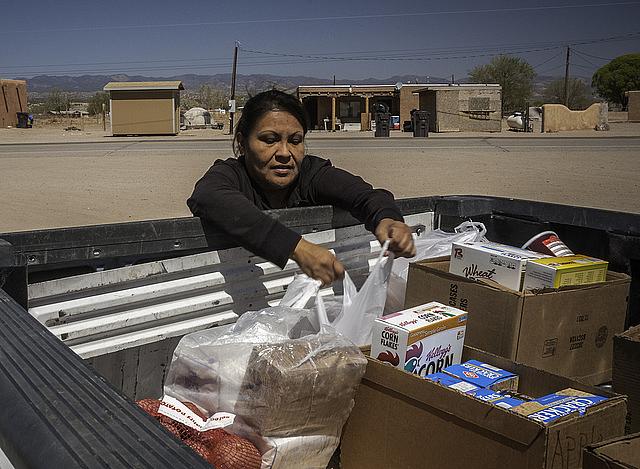How are Native American tribes dealing with food insecurity?

In New Mexico, Lynette Quintana loads up food from the USDA’s Food Distribution Program on Indian Reservations.
Food is tied to the historical trauma that still persists in Indian Country.
During the attempted genocide of the 18th, 19th and early 20th centuries, many traditional food sources were either entirely eliminated or pushed to the brink of extinction thanks to removal campaigns or excessive hunting. Starvation was not an uncommon tactic used to force tribes into submission.
Many dishes that are now considered “traditional” by mainstream society, like the ubiquitous Indian taco (or, if you’re in the Four Corners area, a “Navajo taco”), trace their roots to the reservation era when agents with the Bureau of Indian Affairs would ration out flour, salt, pepper, lard and other basic staples.
For many contemporary Native communities, with a quarter of Native families nationwide living below the poverty line, accessing healthy food in any form is a challenge. Despite accounting for about 1 percent of the total U.S. population, 12.2 percent of all WIC participants are Native American, including 13.7 percent of all children served by the program. Data from the First Nations Development Institute places the SNAP (food stamps) participation rate among Native households at 24 percent, compared to 13 percent of the general population. Additionally, an estimated 900,000 Native students nationwide participate in the U.S. Department of Agriculture’s free and reduced school lunch program.
There is some federal support for rural Native communities through the United States Department of Agriculture’s Food Distribution Program on Indian Reservations, which relies on the same income eligibility guidelines as SNAP but determines how much food a family is given by its size rather than its finances. However, the program’s total budget for all communities nationwide in 2014 was $104 million to serve 276 of the 567 federally recognized tribes nationwide. With an estimated 83,000 participants per month, that figure comes to less than $1 per meal per person.
Those distribution sites, along with some WIC and SNAP programs, are overseen at the local level by tribal governments, but for the most part, still come with federal strings.
Under Public Law 93-638, also known as the Indian Self-Determination and Education Assistance Act, federally recognized tribes have the option to request a contract with the government to directly control a local program, typically administered by a department of the federal government, such as an area clinic run by Indian Health Services or a Bureau of Indian Education boarding school. Once a 638 contract is in place, the tribe has complete oversight of the program and is able use federal funds in order to tailor it to better suit local needs. Accounting for more than $1 billion of IHS’ annual budget, self-governance compacts are most common in the health sector, but are not restricted to that particular area.
So for my Dennis A. Hunt Grant-funded National Health Journalism Fellowship project, I will be looking at what resources tribes are using – or not using – to address food insecurity among their citizens.
The project will largely depend on what I get back from my records requests for all current self-governance compacts for WIC, SNAP, TANF, FDIPR and school meal programs.
Depending on how many contracts are out, look for stories focusing on the number and nature of those agreements (i.e. are they all for WIC? Are there geographic patterns?) and what tweaks, if any, are tribal governments making to better serve their local needs.
If there are not any self-governance compacts out for those programs or there are only a handful, there will be a story explaining why that resource has not been tapped, as well as an examination of what tribally-funded programs are being utilized instead.
Regardless of the FOIA results, I will also take a look at economic development opportunities being pursued to tackle the issue while also confronting some of the underlying factors that exacerbate the problem, including poverty and a simple lack of access. For example, Navajo Nation recently enacted food-related changes to its tax code. In 2014, the Osage Nation, based in northeastern Oklahoma, signed a lease to reopen a grocery store in the southwestern corner of its jurisdictional area, eliminating a 30-minute one-way trip for area residents.
[Photo by USDA via Flickr.]

